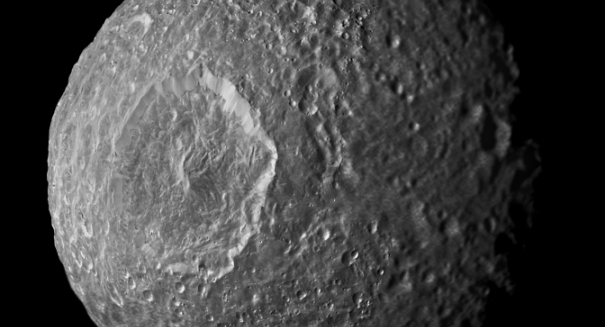
Saturn's moon Mimas could possibly harbor a vast subterranean ocean beneath its icy crust.
Called the “Death Star” moon because it resembles the legendary Star Wars craft, Saturn’s moon Mimas has been labeled either “wobbly” or “watery.” The moon has a distinct orbital wobble that led researchers to hypothesize that Mimas either contains a rocky core or a vast, icy ocean.
Pictures snapped by the Cassini spacecraft have helped astronomers in France, Belgium, and the United States determine that there’s definitely something a little strange about Mimas. The moon wobbles and swivels to a much greater extent than most other moons.
The Cassini spacecraft, sent in 1997 to explore Saturn and its 62 moons, took detailed high-resolution photographs of Mimas. These allowed researchers to create a 3D model of the moon and its various pockmarks and movements.
According to lead author Dr. Radwan Tajeddine of Cornell University, “After carefully examining Mimas, we found it librates – that is, it subtly wobbles – around the moon’s polar axis.”
While many moons have a small wobble- ours included- Mimas’s wobble is 6 km, roughly twice what the researchers had expected. Mimas is pockmarked by the enormous Herschel Crater, but even that would not explain the moon’s distinct swiveling motion. This led them to conclude that Mimas’s composition could be different than that of Saturn’s other moons.
Dr. Tajeddine’s team formulated two theories. The first was that Mimas’s core could consist of a squashed rock that was elongated by 20-60 km. The second, favored by the team, was that Mimas’s icy crust hid a vast, icy ocean.
“When we saw this wobbling, the first thing we thought of was an ocean,” said Dr. Tajeddine.
Astrophysicist Chris Lintott of the University of Oxford was surprised at the results. “If you’d asked me before now, I would have said that Mimas is a boring, icy moon. If the ocean is really there, we’re getting to the point where it’s just completely standard for icy moons to have substantial bodies of water inside – and that could have interesting implications for how many of these things could support life.”
Leave a Reply